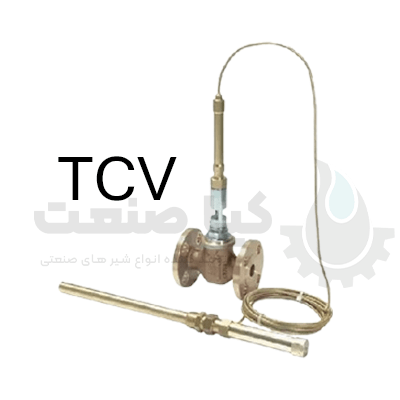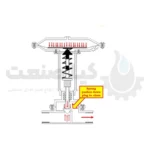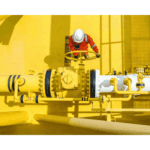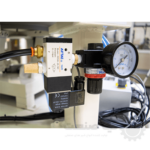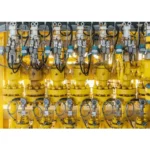The temperature control valve is one of the most widely used control valves.
These valves are used in various industrial applications to control fluid temperature.
The efficiency of this valve is very important to achieve optimal efficiency. This article mainly explains the function of temperature valve control, its applications and types.
What is TCV or Temperature Control Valve?
A temperature control valve (TCV) is used to control process temperature by adjusting the flow or pressure of thermal fluid in a heating coil, tank shell, compressor, or other heating element. Temperature control valve is also known as temperature regulator.
Temperature control valves are used in processes that need to maintain a stable temperature when the ambient temperature changes.
TCVs are useful in industrial, marine and process control applications where fluids are diverted or mixed to achieve optimum operating temperatures.
They can also be used in a production system to adjust the heat recovery loop temperature to maximize heat recovery and ensure proper engine cooling.
All of this helps deliver optimal temperatures for your process and avoids costly downtime.
Industrial valves for different applications are usually named according to their number of ports.
For example, as the name suggests, a two-way valve consists of two ports. A three-way valve consists of three ports. The valve port is the connection point of the valve to which fluids enter or exit.
TCV can sometimes be used to regulate engine temperature, and a faulty temperature valve control can cause system failure.
Temperature valve control components
Before talking about the function of temperature control valves, it is necessary to understand their design. The temperature control valve consists of 4 main components:
Temperature sensor
sensor
Power supply
Controlling media
The temperature sensor element is responsible for sending a mechanical or electrical signal to an actuator. With this signal, the actuator acts on the voltage source that measures the position of the valve.
The temperature regulator is activated by a mechanical thermometer.
Due to the property of thermal expansion of the material, it swells with increasing temperature. This expansion raises the actuator pressure.
This pressure controls the position of the valve in the regulator, which regulates the flow of refrigerant.
Function of the temperature control valve
Temperature control valves use two common methods of temperature control:
Mixing cold and hot process fluids:
In this case, hot and cold process fluids are set at two different temperatures (Tx) and (Ty).
A temperature control valve (TCV) is configured to physically mix these fluids to achieve the desired temperature.
It is vital to note that no chemical reactions take place between the liquids.
The Ty sensor is installed in the hot process fluid.
Tx calculates the temperature of the thermal process fluid and transmits it to the controller with the set point.
When the temperature of the thermal process fluid exceeds Ty, the controller detects the temperature change. The control valve mixes the cold process fluid with the hot process fluid to achieve the desired temperature.
Heat exchange between hot and cold process fluids
In this process, instead of mixing liquids, energy is transferred between two hot and cold process liquids.
This means that the hot fluid flows through the shell of the heat exchanger
while the cold fluid transfers energy through the tubes.
The hot liquid transfers energy to the cold liquid, and the increase in the temperature of the cold liquid is set by a temperature transmitter (temperature transmitter) and transferred to the temperature controller.
As the temperature rises, the controller sends it to the temperature control valve to turn it on or off accordingly. It stays on until the desired temperature is reached and facilitates energy transfer.
Types of temperature control valves
There are generally two types of temperature control valves.
Thermostatic control valves
Actuated Control Valves
Thermostatic valve control
Valves that work by detecting and adjusting the temperature of the liquid inside are called thermostatic control valves.
This temperature control valve is independent and does not need an external power source. The operating temperature range is measured by wax material chemistry and preset at the factory or local dealer as recommended by the engine or equipment manufacturer.
Once the thermostatic element is adjusted to a specific temperature, it cannot be corrected without installing a new element.
This robust yet simple design prevents operators from accidentally overheating or cooling equipment, which leads to poor fuel economy, costly repairs and breakdowns.
Active control valves
Unlike thermostatic valve control, active control valves are usually part of a complete system that uses an external probe to detect temperature changes.
The probe transmits a signal to the Powertrain Control Module (PCM) to open and close the valve using an external power source.
Although this type of valve requires more components to function, it has several advantages.
The difference between an active control valve and a thermostatic control valve
Active control valve is more accurate. Therefore, if you need precise temperature control in your system, this method is the best option.
Unlike the thermostatic valve, the active control valve allows you to adjust the temperature range as the operating conditions change.
Application of temperature control valve
Temperature control valves are mostly used for various industrial and residential applications. The main applications of temperature control valves are as follows:
Unit heaters
Small heater batteries
Steam trace lines
irons
Small storage heaters
acid bath
Some of the industries that use temperature control valves are:
Food industry
Oil and gas sectors
In chemical and petrochemical industries
Advantages of temperature control valve
These types of faucets have a low price.
They are small in size.
They are easy to install.
They are very strong and reliable.
It works on a principle which means that no external force is required for movement.
These valves are available in different brands and in different sizes and different temperature ranges.
Disadvantages of temperature control valve
There are limited pressure ratings.
Conclusion
In this article, we have reviewed the application of temperature control valves, the advantages and disadvantages of TCVs, the applications of temperature control valves, etc.
Kiasanat is a supplier of all kinds of valve controls, Samson 3241 valve control, Samson model 3251 valve control, Fisher valve control, Honeywell valve control, Samson three-way valve control, Masonilan valve control, etc.

